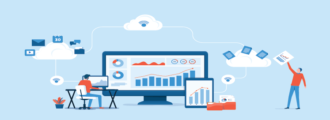For any financial professional, mastering the SAP Revenue Accounting and Reporting (SAP RAR) solution is a game-changer for optimizing your organization’s financial management. This powerful module provides the tools needed to automate revenue accounting processes, streamline financial reporting, and gain real-time visibility.
By leveraging SAP RAR, businesses of all sizes can make more informed decisions and maintain compliance with complex revenue recognition standards. This article will explore the key features and advantages of SAP RAR and explain how our team of expert SAP consultants can help your organization leverage its full potential.
What is RAR in SAP?
SAP RAR (Revenue Accounting and Recognition) is an SAP solution designed to help users comply with evolving International Financial Reporting Standards (IFRS), support existing requirements, and promote more efficient revenue accounting and reporting functions across the entire enterprise.
With the SAP Revenue Accounting and Recognition module, companies in any industry can ensure accurate revenue recognition and reporting and maintain compliance with ever-changing accounting standards and performance obligations.
Common Challenges in Revenue Accounting and Reporting
Let’s take a closer look at a few of the key challenges associated with reporting revenues, managing billing systems, and supporting different performance obligation and revenue recognition types across organizations…
1) Keeping up with IFRS updates.
With the release of IFRS 15, a standard created to further document the main steps of the revenue recognition framework, companies must ensure their revenue accounting and reporting functions comply accordingly.
For your company to remain in compliance, your employees must fully understand current IFRS standards, and your financial system should be continuously adjusted to keep your SAP Revenue Accounting and Reporting functions aligned with any changes in rules or standards.
2) Meeting FASB requirements.
FASB, Financial Accounting Standards Board, ASC 606 is another financial reporting standard created to monitor revenue from contracts with customers, including a revision in GAAP rules related to how and when companies report service revenues.
To accurately recognize revenues and maintain compliance with ASC 606, companies must follow a five-step framework for recognition. The FASB creates these standards, and companies often face challenges in accurately reporting service revenues while simultaneously following the defined steps in the pre-configured recognition framework.
3) Recognizing time and event-based revenues.
In time-based revenue recognition, billing documentation, including financial statements and revenue postings, is posted to an accrual account in which the appropriate portion of the accrual is transferred to revenue each period. While time-based recognition is an ideal choice for long-term service contracts, the need for periodic posting poses a challenge for most teams.
Event-based revenue recognition also generates an accrual for revenues, but, unlike time-based recognition, accruals are transferred directly to revenue based on an actual event related to the service contract, rather than a specific time period.
4) Allocating transaction prices.
Another main challenge associated with accurately reporting revenues and managing contracts is transaction price allocation, which involves determining the price of each transaction by identifying the prices of similar products or services.
And, because contracts can be complicated, determining the right level of judgment to use when allocating the pricing of performance for activities and allocating transaction prices related to contract obligations can be quite the struggle without the right resources.
Key Solutions Provided in SAP RAR
The revenue recognition framework and key features in SAP’s Revenue Accounting and Recognition module offer the necessary functionality and flexibility to address common revenue accounting and reporting challenges.
Here are a few of the key capabilities of RAR for SAP customers…
- Create revenue accounting contracts that correspond to documents in an organization’s back-end operational system
- Aggregate pricing conditions in the back-end system to determine the total price
- Allocate the total price across each individual performance obligation (POB)
- Identify performance obligations in each contract and manage POB relationships
- Manage the fulfillment of performance obligations and recognize revenue once each POB has been fulfilled
- Make postings to the general ledger to accurately depict revenue-related transactions
Where Does IFRS 15 Come Into Play?
The SAP RAR module offers an intuitive and flexible solution to help companies maintain compliance with the requirements of IFRS 15, Revenue from Contracts with Customers. The main objective of the new IFRS 15 standard is to give customers a single, comprehensive guide to revenue recognition through an outlined five-step process.
The IFRS 15 framework, paired with the SAP RAR module, improves comparability in and across industries, facilitates more efficient revenue recognition, and guarantees compliance with standards and regulatory requirements for any enterprise.
5 Steps to Apply IFRS 15 Standards in SAP RAR
1) Identify revenue accounting contracts.
A contract is identified and entered into SAP RAR, including terms of the contract, responsibilities of working parties, and other relevant information for accounting purposes.
2) Determine performance obligations.
Once the contract is outlined, users will identify performance obligations (POBs), which are essentially promises to deliver transferable goods or perform a service for the customer.
3) Establish transaction price.
The transaction price will determine how much a good is sold for or the price of a performed service. Establishing a set transaction price for goods and services offers transparency for customers and keeps everyone on the same page throughout the revenue recognition process.
4) Allocate price to performance obligations.
Whether you have one performance obligation or 10 different POBs, a critical step in the revenue recognition process requires companies to allocate transaction prices between the POBs in the ratio of their standalone selling price (SSP).
5) Recognize revenues.
Revenues for all POBs will be recognized according to the nature of the POB itself, such as recognizing revenue when a device is delivered for a Device POB or recognizing revenue in equal amounts across a specific time period for a Subscription POB.
How Can We Help?
Whether you need help implementing the SAP Revenue Accounting and Reporting module for the first time, additional support decoupling revenue realization rules for your billing and order systems, or an extra hand integrating SAP RAR with non-SAP systems for improved functionality and efficiency, Surety Systems is here to help.
Our team of senior-level SAP consultants has the technical skills and functional knowledge needed to lead you to success, regardless of the complexity of your internal billing systems or the nature of your revenue accounting needs.
Partnering with Our Team
Interested in learning where our expert SAP consultants can fit in your organization? Ready to get started on your journey with SAP ERP software, but don’t know where to begin? Contact us today for more information!




